An Analysis of Recycling Construction Sites in Australia: Challenges
VerifiedAdded on 2021/06/16
|6
|1497
|131
Report
AI Summary
This research paper addresses the challenges of recycling construction sites in Australia, focusing on waste management and sustainability. It highlights the environmental problems caused by construction waste, including soil pollution and weakened foundations. The paper identifies various waste materials like roofing, wiring, and rubble, along with their sources and associated issues such as asbestos and lead. The study suggests solutions like recovering, reusing, and recycling demolished waste to minimize landfill capacity and embodied energy use. The paper also discusses the impacts of material waste on construction costs, illegal dumping, and project delays. It proposes steps like waste prevention, reduction, reuse, recycling, and recovery. The conclusion emphasizes the importance of waste management in construction sites to mitigate environmental impacts and promote sustainable practices. The report provides a detailed analysis of the problems and solutions in the context of recycling construction sites in Australia, offering valuable insights for civil engineers and construction professionals.
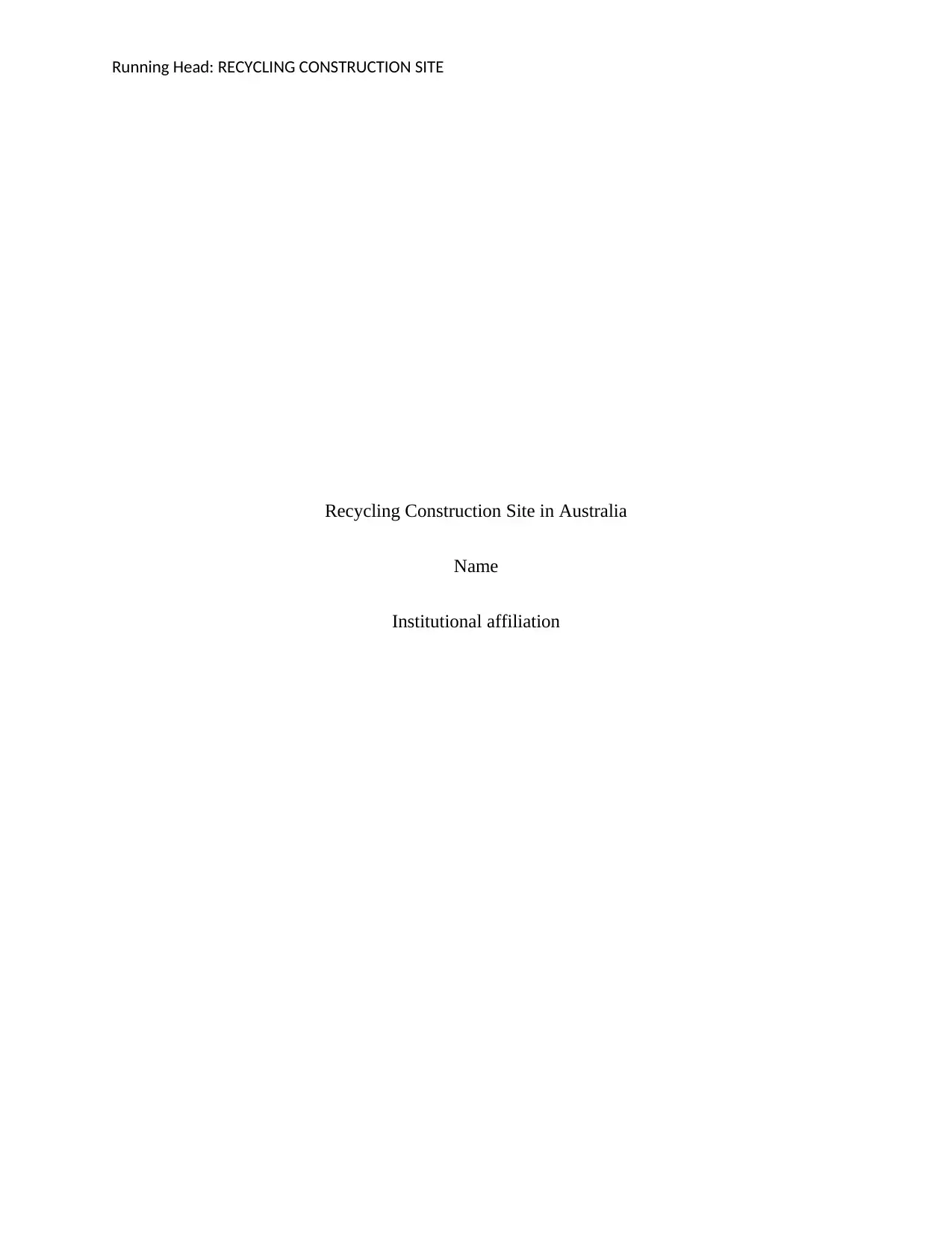
Running Head: RECYCLING CONSTRUCTION SITE
Recycling Construction Site in Australia
Name
Institutional affiliation
Recycling Construction Site in Australia
Name
Institutional affiliation
Paraphrase This Document
Need a fresh take? Get an instant paraphrase of this document with our AI Paraphraser
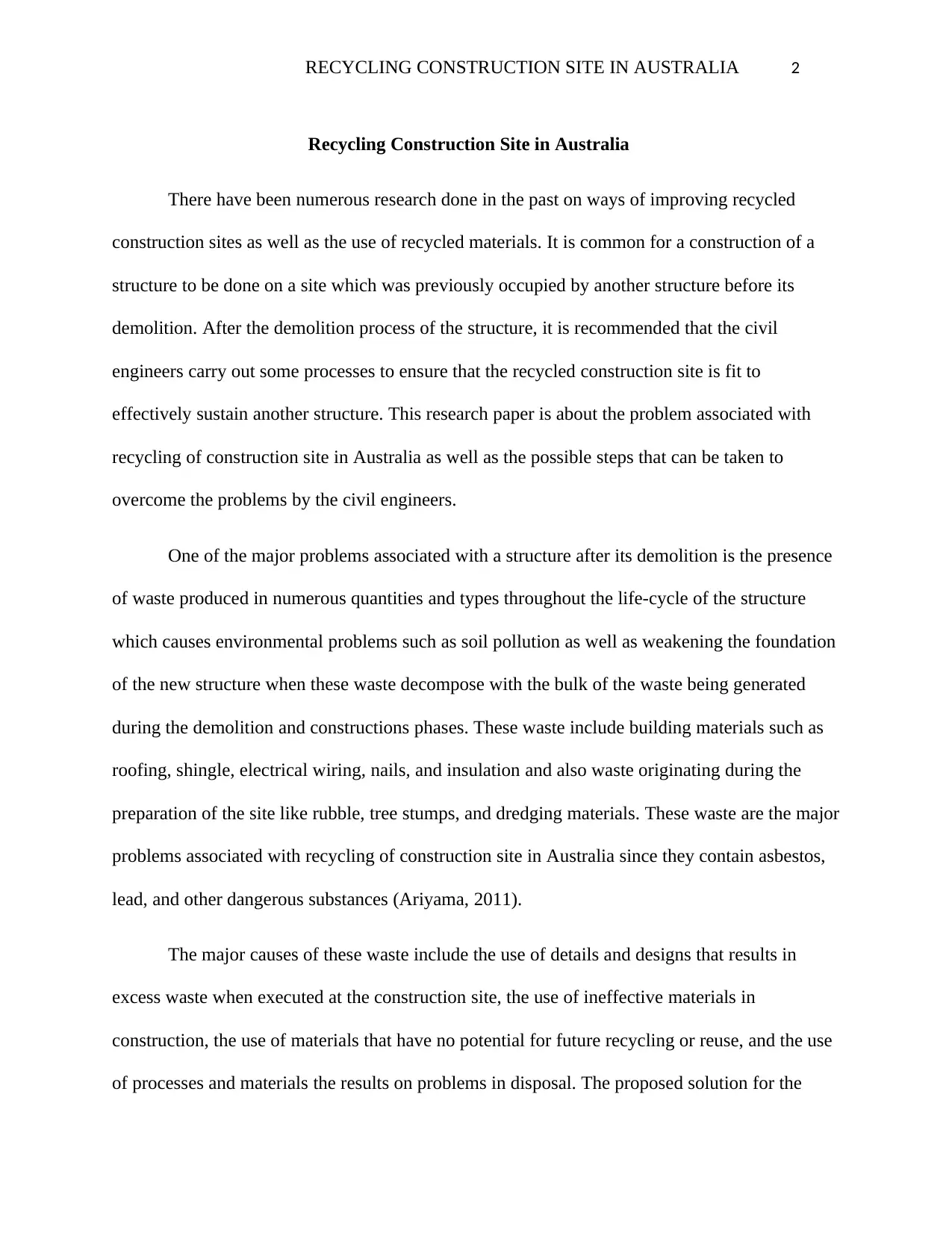
RECYCLING CONSTRUCTION SITE IN AUSTRALIA 2
Recycling Construction Site in Australia
There have been numerous research done in the past on ways of improving recycled
construction sites as well as the use of recycled materials. It is common for a construction of a
structure to be done on a site which was previously occupied by another structure before its
demolition. After the demolition process of the structure, it is recommended that the civil
engineers carry out some processes to ensure that the recycled construction site is fit to
effectively sustain another structure. This research paper is about the problem associated with
recycling of construction site in Australia as well as the possible steps that can be taken to
overcome the problems by the civil engineers.
One of the major problems associated with a structure after its demolition is the presence
of waste produced in numerous quantities and types throughout the life-cycle of the structure
which causes environmental problems such as soil pollution as well as weakening the foundation
of the new structure when these waste decompose with the bulk of the waste being generated
during the demolition and constructions phases. These waste include building materials such as
roofing, shingle, electrical wiring, nails, and insulation and also waste originating during the
preparation of the site like rubble, tree stumps, and dredging materials. These waste are the major
problems associated with recycling of construction site in Australia since they contain asbestos,
lead, and other dangerous substances (Ariyama, 2011).
The major causes of these waste include the use of details and designs that results in
excess waste when executed at the construction site, the use of ineffective materials in
construction, the use of materials that have no potential for future recycling or reuse, and the use
of processes and materials the results on problems in disposal. The proposed solution for the
Recycling Construction Site in Australia
There have been numerous research done in the past on ways of improving recycled
construction sites as well as the use of recycled materials. It is common for a construction of a
structure to be done on a site which was previously occupied by another structure before its
demolition. After the demolition process of the structure, it is recommended that the civil
engineers carry out some processes to ensure that the recycled construction site is fit to
effectively sustain another structure. This research paper is about the problem associated with
recycling of construction site in Australia as well as the possible steps that can be taken to
overcome the problems by the civil engineers.
One of the major problems associated with a structure after its demolition is the presence
of waste produced in numerous quantities and types throughout the life-cycle of the structure
which causes environmental problems such as soil pollution as well as weakening the foundation
of the new structure when these waste decompose with the bulk of the waste being generated
during the demolition and constructions phases. These waste include building materials such as
roofing, shingle, electrical wiring, nails, and insulation and also waste originating during the
preparation of the site like rubble, tree stumps, and dredging materials. These waste are the major
problems associated with recycling of construction site in Australia since they contain asbestos,
lead, and other dangerous substances (Ariyama, 2011).
The major causes of these waste include the use of details and designs that results in
excess waste when executed at the construction site, the use of ineffective materials in
construction, the use of materials that have no potential for future recycling or reuse, and the use
of processes and materials the results on problems in disposal. The proposed solution for the
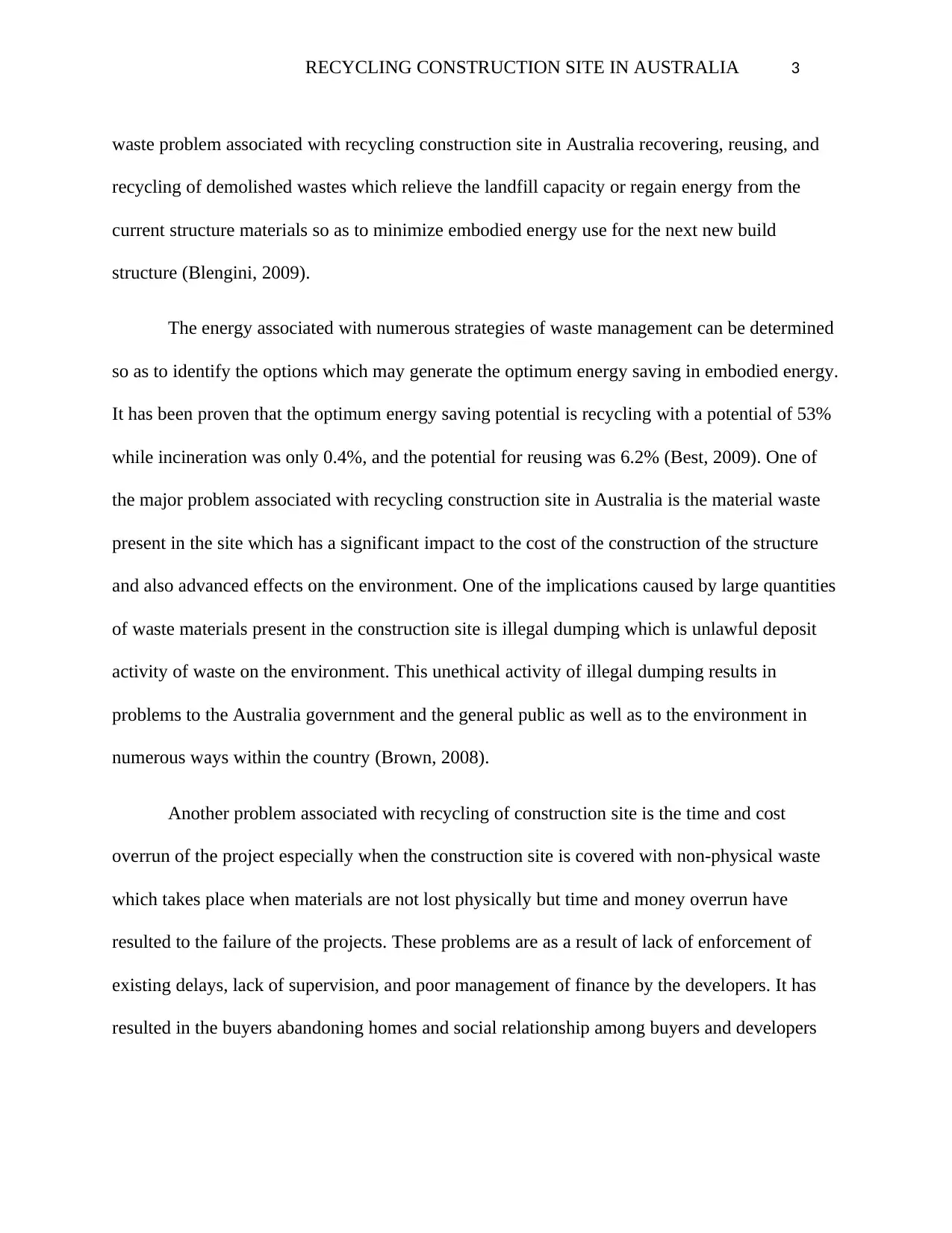
RECYCLING CONSTRUCTION SITE IN AUSTRALIA 3
waste problem associated with recycling construction site in Australia recovering, reusing, and
recycling of demolished wastes which relieve the landfill capacity or regain energy from the
current structure materials so as to minimize embodied energy use for the next new build
structure (Blengini, 2009).
The energy associated with numerous strategies of waste management can be determined
so as to identify the options which may generate the optimum energy saving in embodied energy.
It has been proven that the optimum energy saving potential is recycling with a potential of 53%
while incineration was only 0.4%, and the potential for reusing was 6.2% (Best, 2009). One of
the major problem associated with recycling construction site in Australia is the material waste
present in the site which has a significant impact to the cost of the construction of the structure
and also advanced effects on the environment. One of the implications caused by large quantities
of waste materials present in the construction site is illegal dumping which is unlawful deposit
activity of waste on the environment. This unethical activity of illegal dumping results in
problems to the Australia government and the general public as well as to the environment in
numerous ways within the country (Brown, 2008).
Another problem associated with recycling of construction site is the time and cost
overrun of the project especially when the construction site is covered with non-physical waste
which takes place when materials are not lost physically but time and money overrun have
resulted to the failure of the projects. These problems are as a result of lack of enforcement of
existing delays, lack of supervision, and poor management of finance by the developers. It has
resulted in the buyers abandoning homes and social relationship among buyers and developers
waste problem associated with recycling construction site in Australia recovering, reusing, and
recycling of demolished wastes which relieve the landfill capacity or regain energy from the
current structure materials so as to minimize embodied energy use for the next new build
structure (Blengini, 2009).
The energy associated with numerous strategies of waste management can be determined
so as to identify the options which may generate the optimum energy saving in embodied energy.
It has been proven that the optimum energy saving potential is recycling with a potential of 53%
while incineration was only 0.4%, and the potential for reusing was 6.2% (Best, 2009). One of
the major problem associated with recycling construction site in Australia is the material waste
present in the site which has a significant impact to the cost of the construction of the structure
and also advanced effects on the environment. One of the implications caused by large quantities
of waste materials present in the construction site is illegal dumping which is unlawful deposit
activity of waste on the environment. This unethical activity of illegal dumping results in
problems to the Australia government and the general public as well as to the environment in
numerous ways within the country (Brown, 2008).
Another problem associated with recycling of construction site is the time and cost
overrun of the project especially when the construction site is covered with non-physical waste
which takes place when materials are not lost physically but time and money overrun have
resulted to the failure of the projects. These problems are as a result of lack of enforcement of
existing delays, lack of supervision, and poor management of finance by the developers. It has
resulted in the buyers abandoning homes and social relationship among buyers and developers
⊘ This is a preview!⊘
Do you want full access?
Subscribe today to unlock all pages.

Trusted by 1+ million students worldwide
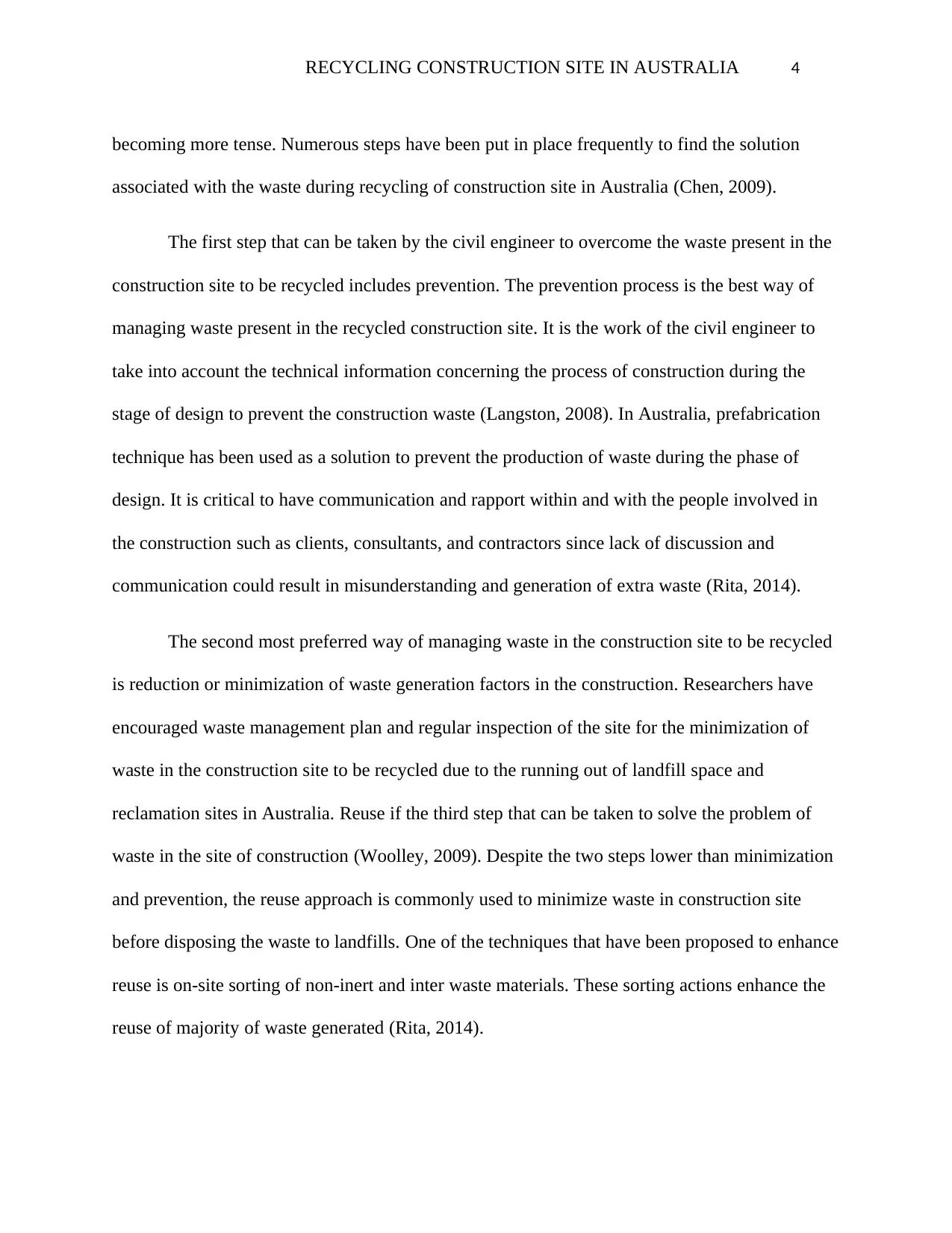
RECYCLING CONSTRUCTION SITE IN AUSTRALIA 4
becoming more tense. Numerous steps have been put in place frequently to find the solution
associated with the waste during recycling of construction site in Australia (Chen, 2009).
The first step that can be taken by the civil engineer to overcome the waste present in the
construction site to be recycled includes prevention. The prevention process is the best way of
managing waste present in the recycled construction site. It is the work of the civil engineer to
take into account the technical information concerning the process of construction during the
stage of design to prevent the construction waste (Langston, 2008). In Australia, prefabrication
technique has been used as a solution to prevent the production of waste during the phase of
design. It is critical to have communication and rapport within and with the people involved in
the construction such as clients, consultants, and contractors since lack of discussion and
communication could result in misunderstanding and generation of extra waste (Rita, 2014).
The second most preferred way of managing waste in the construction site to be recycled
is reduction or minimization of waste generation factors in the construction. Researchers have
encouraged waste management plan and regular inspection of the site for the minimization of
waste in the construction site to be recycled due to the running out of landfill space and
reclamation sites in Australia. Reuse if the third step that can be taken to solve the problem of
waste in the site of construction (Woolley, 2009). Despite the two steps lower than minimization
and prevention, the reuse approach is commonly used to minimize waste in construction site
before disposing the waste to landfills. One of the techniques that have been proposed to enhance
reuse is on-site sorting of non-inert and inter waste materials. These sorting actions enhance the
reuse of majority of waste generated (Rita, 2014).
becoming more tense. Numerous steps have been put in place frequently to find the solution
associated with the waste during recycling of construction site in Australia (Chen, 2009).
The first step that can be taken by the civil engineer to overcome the waste present in the
construction site to be recycled includes prevention. The prevention process is the best way of
managing waste present in the recycled construction site. It is the work of the civil engineer to
take into account the technical information concerning the process of construction during the
stage of design to prevent the construction waste (Langston, 2008). In Australia, prefabrication
technique has been used as a solution to prevent the production of waste during the phase of
design. It is critical to have communication and rapport within and with the people involved in
the construction such as clients, consultants, and contractors since lack of discussion and
communication could result in misunderstanding and generation of extra waste (Rita, 2014).
The second most preferred way of managing waste in the construction site to be recycled
is reduction or minimization of waste generation factors in the construction. Researchers have
encouraged waste management plan and regular inspection of the site for the minimization of
waste in the construction site to be recycled due to the running out of landfill space and
reclamation sites in Australia. Reuse if the third step that can be taken to solve the problem of
waste in the site of construction (Woolley, 2009). Despite the two steps lower than minimization
and prevention, the reuse approach is commonly used to minimize waste in construction site
before disposing the waste to landfills. One of the techniques that have been proposed to enhance
reuse is on-site sorting of non-inert and inter waste materials. These sorting actions enhance the
reuse of majority of waste generated (Rita, 2014).
Paraphrase This Document
Need a fresh take? Get an instant paraphrase of this document with our AI Paraphraser
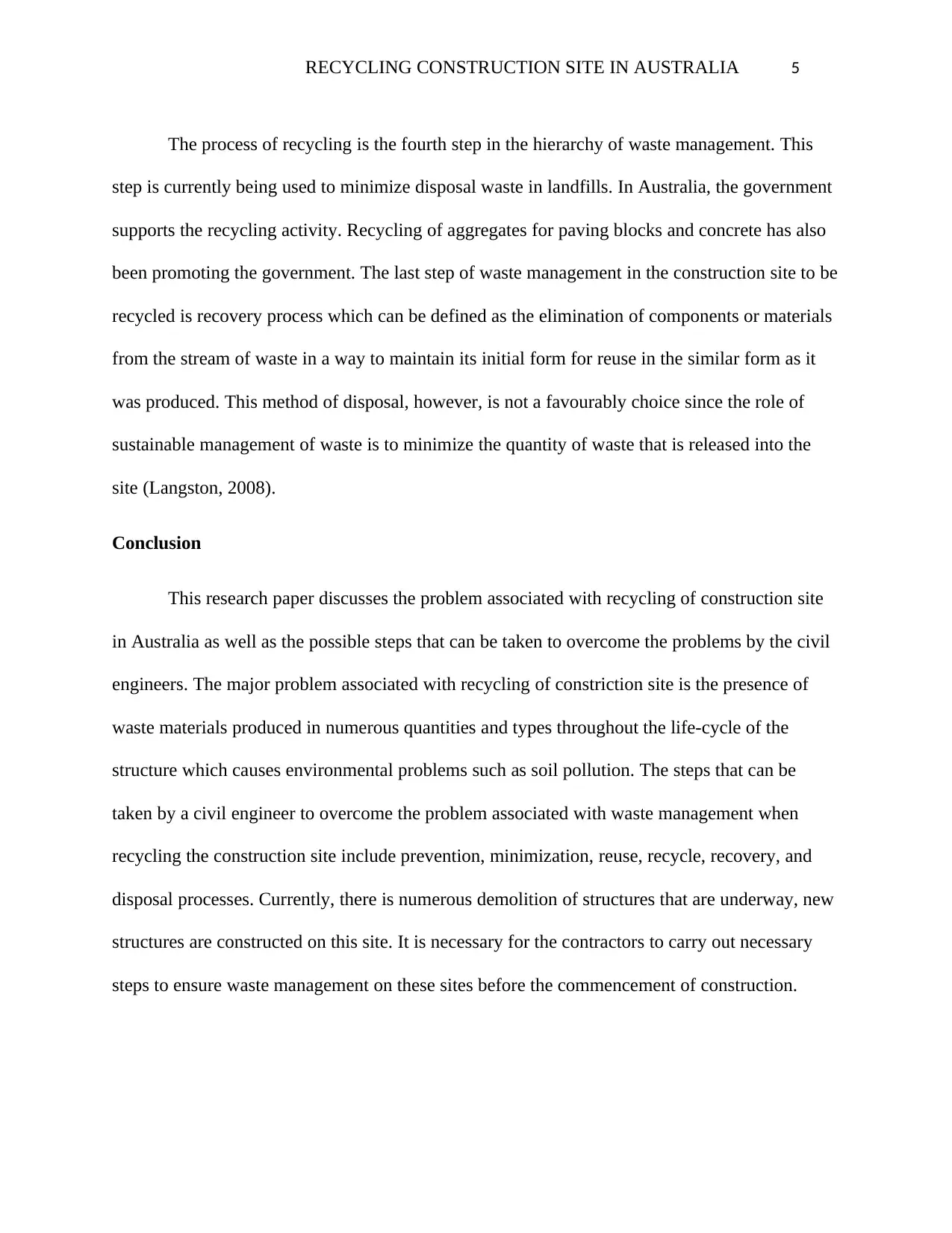
RECYCLING CONSTRUCTION SITE IN AUSTRALIA 5
The process of recycling is the fourth step in the hierarchy of waste management. This
step is currently being used to minimize disposal waste in landfills. In Australia, the government
supports the recycling activity. Recycling of aggregates for paving blocks and concrete has also
been promoting the government. The last step of waste management in the construction site to be
recycled is recovery process which can be defined as the elimination of components or materials
from the stream of waste in a way to maintain its initial form for reuse in the similar form as it
was produced. This method of disposal, however, is not a favourably choice since the role of
sustainable management of waste is to minimize the quantity of waste that is released into the
site (Langston, 2008).
Conclusion
This research paper discusses the problem associated with recycling of construction site
in Australia as well as the possible steps that can be taken to overcome the problems by the civil
engineers. The major problem associated with recycling of constriction site is the presence of
waste materials produced in numerous quantities and types throughout the life-cycle of the
structure which causes environmental problems such as soil pollution. The steps that can be
taken by a civil engineer to overcome the problem associated with waste management when
recycling the construction site include prevention, minimization, reuse, recycle, recovery, and
disposal processes. Currently, there is numerous demolition of structures that are underway, new
structures are constructed on this site. It is necessary for the contractors to carry out necessary
steps to ensure waste management on these sites before the commencement of construction.
The process of recycling is the fourth step in the hierarchy of waste management. This
step is currently being used to minimize disposal waste in landfills. In Australia, the government
supports the recycling activity. Recycling of aggregates for paving blocks and concrete has also
been promoting the government. The last step of waste management in the construction site to be
recycled is recovery process which can be defined as the elimination of components or materials
from the stream of waste in a way to maintain its initial form for reuse in the similar form as it
was produced. This method of disposal, however, is not a favourably choice since the role of
sustainable management of waste is to minimize the quantity of waste that is released into the
site (Langston, 2008).
Conclusion
This research paper discusses the problem associated with recycling of construction site
in Australia as well as the possible steps that can be taken to overcome the problems by the civil
engineers. The major problem associated with recycling of constriction site is the presence of
waste materials produced in numerous quantities and types throughout the life-cycle of the
structure which causes environmental problems such as soil pollution. The steps that can be
taken by a civil engineer to overcome the problem associated with waste management when
recycling the construction site include prevention, minimization, reuse, recycle, recovery, and
disposal processes. Currently, there is numerous demolition of structures that are underway, new
structures are constructed on this site. It is necessary for the contractors to carry out necessary
steps to ensure waste management on these sites before the commencement of construction.
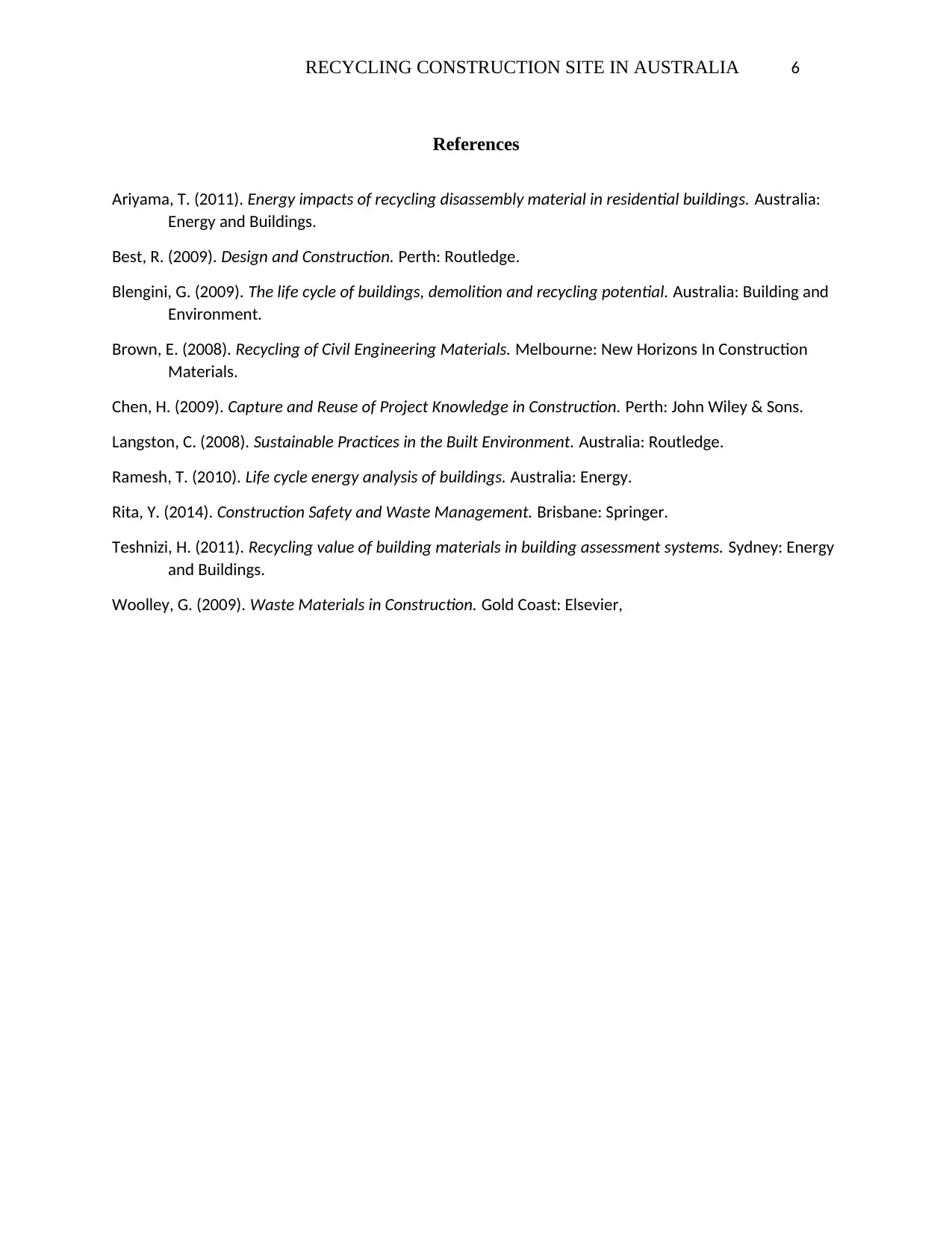
RECYCLING CONSTRUCTION SITE IN AUSTRALIA 6
References
Ariyama, T. (2011). Energy impacts of recycling disassembly material in residential buildings. Australia:
Energy and Buildings.
Best, R. (2009). Design and Construction. Perth: Routledge.
Blengini, G. (2009). The life cycle of buildings, demolition and recycling potential. Australia: Building and
Environment.
Brown, E. (2008). Recycling of Civil Engineering Materials. Melbourne: New Horizons In Construction
Materials.
Chen, H. (2009). Capture and Reuse of Project Knowledge in Construction. Perth: John Wiley & Sons.
Langston, C. (2008). Sustainable Practices in the Built Environment. Australia: Routledge.
Ramesh, T. (2010). Life cycle energy analysis of buildings. Australia: Energy.
Rita, Y. (2014). Construction Safety and Waste Management. Brisbane: Springer.
Teshnizi, H. (2011). Recycling value of building materials in building assessment systems. Sydney: Energy
and Buildings.
Woolley, G. (2009). Waste Materials in Construction. Gold Coast: Elsevier,
References
Ariyama, T. (2011). Energy impacts of recycling disassembly material in residential buildings. Australia:
Energy and Buildings.
Best, R. (2009). Design and Construction. Perth: Routledge.
Blengini, G. (2009). The life cycle of buildings, demolition and recycling potential. Australia: Building and
Environment.
Brown, E. (2008). Recycling of Civil Engineering Materials. Melbourne: New Horizons In Construction
Materials.
Chen, H. (2009). Capture and Reuse of Project Knowledge in Construction. Perth: John Wiley & Sons.
Langston, C. (2008). Sustainable Practices in the Built Environment. Australia: Routledge.
Ramesh, T. (2010). Life cycle energy analysis of buildings. Australia: Energy.
Rita, Y. (2014). Construction Safety and Waste Management. Brisbane: Springer.
Teshnizi, H. (2011). Recycling value of building materials in building assessment systems. Sydney: Energy
and Buildings.
Woolley, G. (2009). Waste Materials in Construction. Gold Coast: Elsevier,
⊘ This is a preview!⊘
Do you want full access?
Subscribe today to unlock all pages.

Trusted by 1+ million students worldwide
1 out of 6
Related Documents
Your All-in-One AI-Powered Toolkit for Academic Success.
+13062052269
info@desklib.com
Available 24*7 on WhatsApp / Email
![[object Object]](/_next/static/media/star-bottom.7253800d.svg)
Unlock your academic potential
Copyright © 2020–2025 A2Z Services. All Rights Reserved. Developed and managed by ZUCOL.





